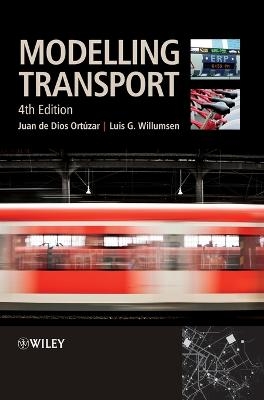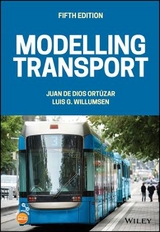
Modelling Transport
John Wiley & Sons Inc (Verlag)
978-0-470-76039-0 (ISBN)
Already the market leader in the field, Modelling Transport has become still more indispensible following a thorough and detailed update. Enhancements include two entirely new chapters on modelling for private sector projects and on activity-based modelling; a new section on dynamic assignment and micro-simulation; and sizeable updates to sections on disaggregate modelling and stated preference design and analysis. It also tackles topical issues such as valuation of externalities and the role of GPS in travel time surveys. Providing unrivalled depth and breadth of coverage, each topic is approached as a modelling exercise with discussion of the roles of theory, data, model specification, estimation, validation and application. The authors present the state of the art and its practical application in a pedagogic manner, easily understandable to both students and practitioners.
Follows on from the highly successful third edition universally acknowledged as the leading text on transport modelling techniques and applications
Includes two new chapters on modelling for private sector projects and activity based modeling, and numerous updates to existing chapters
Incorporates treatment of recent issues and concerns like risk analysis and the dynamic interaction between land use and transport
Provides comprehensive and rigorous information and guidance, enabling readers to make practical use of every available technique
Relates the topics to new external factors and technologies such as global warming, valuation of externalities and global positioning systems (GPS).
Professor Juan de Dios Ortúzar currently works for the Department of Transport Engineering and Logistics, Pontificia Universidad, Chile. He has over 30 years experience as an academic and advisor on transport modelling and social project evaluation. He has fostered the development of discrete choice models and its application to determining willingness-to-pay for reducing transport externalities. Luis G. Willumsen currently works as Technical Director for the transport planning consultancy Steer Davies Gleave in London. Luis has over thirty year of experience as a consultant, transport planner and researcher with a distinguished academic career. As an Information Technology specialist Luis has been involved in research into electronic toll collection, image processing techniques, incident detection, computer-assisted design of roundabouts and the development of expert systems for bus priority schemes.
About the Authors. Preface.
1 Introduction.
1.1 Transport Planning and Modelling.
1.2 Characteristics of Transport Problems.
1.3 Modelling and Decision Making.
1.4 Issues in Transport Modelling.
1.5 The Structure of the Classic Transport Model.
1.6 Continuous Transport Planning.
1.7 Theoretical Basis Versus Expedience.
2 Mathematical Prerequisites.
2.1 Introduction.
2.2 Algebra and Functions.
2.3 Matrix Algebra.
2.4 Elements of Calculus.
2.5 Elementary Mathematical Statistics.
3 Data and Space.
3.1 Basic Sampling Theory.
3.2 Errors in Modelling and Forecasting.
3.3 Basic Data-Collection Methods.
3.4 Stated Preference Surveys.
3.5 Network and Zoning Systems.
Exercises.
4 Trip Generation Modelling.
4.1 Introduction.
4.2 Regression Analysis.
4.3 Cross-Classification or Category Analysis.
4.4 Trip Generation and Accessibility.
4.5 The Frequency Choice Logit Model.
4.6 Forecasting Variables in Trip Generation Analysis.
4.7 Stability and Updating of Trip Generation Parameters.
Exercises.
5 Trip Distribution Modelling.
5.1 Definitions and Notation.
5.2 Growth-Factor Methods.
5.3 Synthetic or Gravity Models.
5.4 The Entropy-Maximising Approach.
5.5 Calibration of Gravity Models.
5.6 The Tri-proportional Approach.
5.7 Other Synthetic Models.
5.8 Practical Considerations.
Exercises.
6 Modal Split and Direct Demand Models.
6.1 Introduction.
6.2 Factors Influencing the Choice of Mode.
6.3 Trip-end Modal-split Models.
6.4 Trip Interchange Heuristics Modal-split Models.
6.5 Synthetic Models.
6.6 Direct Demand Models.
Exercises.
7 Discrete Choice Models.
7.1 General Considerations.
7.2 Theoretical Framework.
7.3 The Multinomial Logit Model (MNL).
7.4 The Nested Logit Model (NL).
7.5 The Multinomial Probit Model.
7.6 The Mixed Logit Model.
7.7 Other Choice Models and Paradigms
8 Specification and Estimation of Discrete Choice Models.
8.1 Introduction.
8.2 Choice-Set Determination.
8.3 Specification and Functional Form.
8.4 Statistical Estimation.
8.5 Estimating the Multinomial Probit Model.
8.6 Estimating the Mixed Logit Model.
8.7 Modelling with Stated-Preference Data.
Exercises.
9 Model Aggregation and Transferability.
9.1 Introduction.
9.2 Aggregation Bias and Forecasting.
9.3 Confidence Intervals for Predictions.
9.4 Aggregation Methods.
9.5 Model Updating or Transferance.
Exercises.
10 Assignment.
10.1 Basic Concepts.
10.2 Traffic Assignment Methods.
10.3 All-or-nothing Assignment.
10.4 Stochastic Methods.
10.5 Congested Assignment.
10.6 Public-Transport Assignment.
10.7 Limitations of the Classic Methods.
10.8 Practical Considerations.
Exercises.
11 Equilibrium and Dynamic Assignment.
11.1 Introduction.
11.2 Equilibrium.
11.3 Transport System Equilibrium.
11.4 Traffic Dynamics.
11.5 Departure Time Choice and Assignment.
Exercises.
12 Simplified Transport Demand Models.
12.1 Introduction.
12.2 Sketch Planning Methods.
12.3 Incremental Demand Models.
12.4 Model Estimation from Traffic Counts.
12.5 Marginal and Corridor Models.
12.6 Gaming Simulation.
Exercises.
13 Freight Demand Models.
13.1 Importance.
13.2 Factors Affecting Goods Movements.
13.3 Pricing Freight Services.
13.4 Data Collection for Freight Studies.
13.5 Aggregate Freight Demand Modelling.
13.6 Disaggregate Approaches.
13.7 Some Practical Issues.
14 Activity Based Models.
14.1 Introduction.
14.2 Activities, Tours and Trips.
14.3 Tours, Individuals and Representative Individuals.
14.4 The ABM System.
14.5 Population Synthesis.
14.6 Monte Carlo and Probabilistic Processes.
14.7 Structuring Activities and Tours.
14.8 Solving ABM.
14.9 Refining Activity or Tour Based Models.
14.10 Extending Random Utility Approaches.
15 Key Parameters, Planning Variables and Value Functions.
15.1 Forecasting Planning Variables.
15.2 Land-Use Transport Interaction Modelling.
15.3 Car-Ownership Forecasting.
15.4 The Value of Travel Time.
15.5 Valuing External Effects of Transport.
Exercises.
16 Pricing and Revenue.
16.1 Pricing, Revenue and Forecasting.
16.2 Private Sector Projects.
16.3 Risk.
16.4 Demand Modelling.
16.5 Risk Analysis.
16.6 Concluding Remarks.
References.
Index.
| Erscheint lt. Verlag | 17.5.2011 |
|---|---|
| Verlagsort | New York |
| Sprache | englisch |
| Maße | 175 x 252 mm |
| Gewicht | 1039 g |
| Themenwelt | Naturwissenschaften ► Geowissenschaften ► Geografie / Kartografie |
| Technik | |
| ISBN-10 | 0-470-76039-7 / 0470760397 |
| ISBN-13 | 978-0-470-76039-0 / 9780470760390 |
| Zustand | Neuware |
| Informationen gemäß Produktsicherheitsverordnung (GPSR) | |
| Haben Sie eine Frage zum Produkt? |
aus dem Bereich



